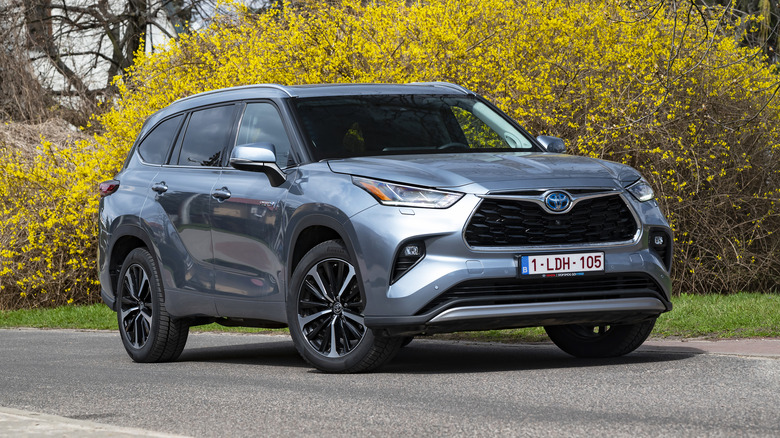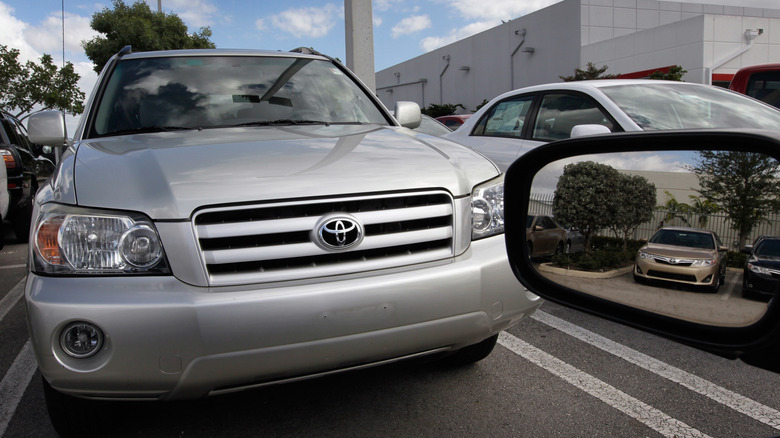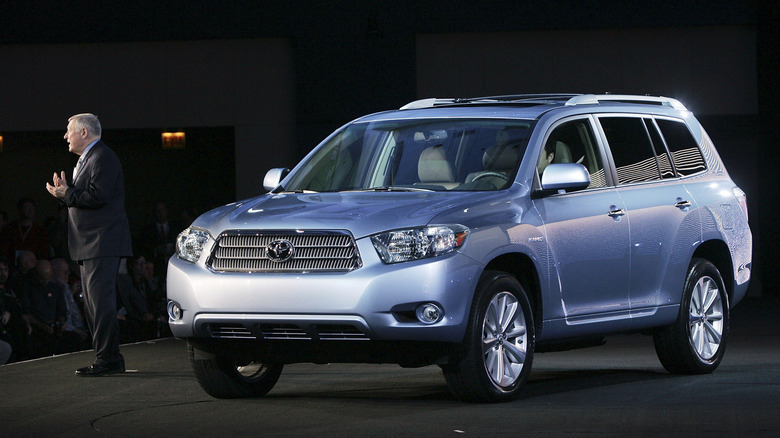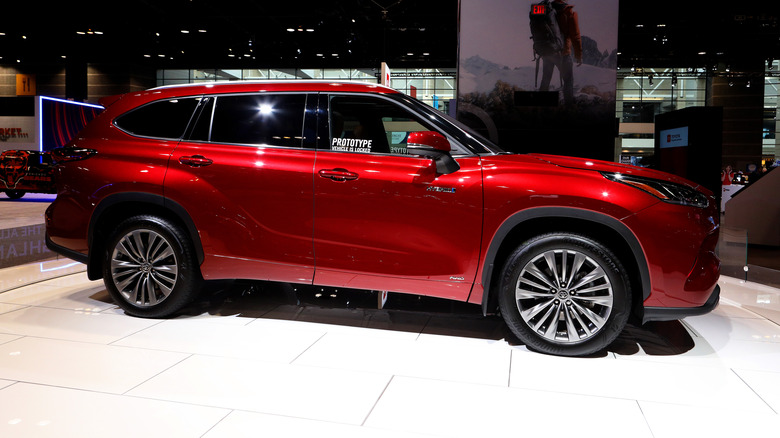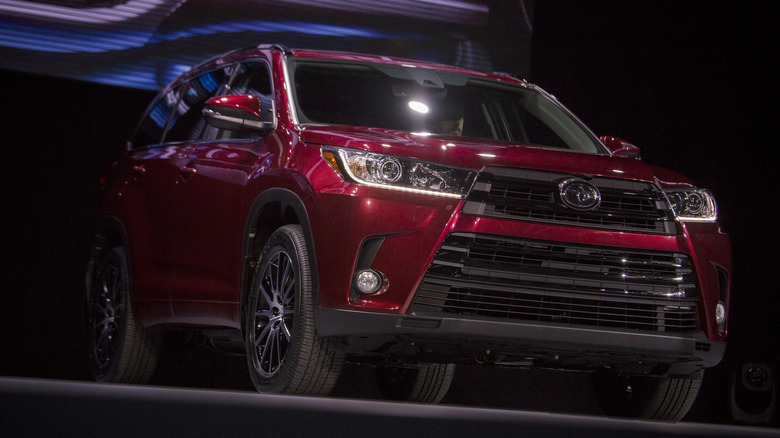Every Toyota Highlander Generation Ranked Worst To Best
The first-generation Toyota Highlander debuted at the 2000 New York Auto Show as a curiosity. It was among the first car-based crossover SUVs that promised a smoother ride and sharper handling. Based on the Toyota K architecture that underpins other Toyotas like the Camry and Sienna minivan, the Highlander became an instant hit and has remained a staple in Toyota's growing SUV lineup.
Toyota recently debuted the Grand Highlander, a genuine three-row crossover SUV with adult-sized third-row seats and an available 362-horsepower hybrid powertrain. Although based on the GA-K platform of the fourth-gen Highlander that went on sale in 2020, it has a wider track and a longer wheelbase to offer more room for passengers and cargo.
The Highlander underwent many changes throughout its four-generation (and counting) lifespan, but which is the best? Toyotas have a solid reputation for durability, reliability, and easy serviceability with their abundance of spare parts and aftermarket support. Still, particular generations or year models of the Highlander stand out, and these are the worst to best years of Toyota's hot-selling crossover SUV based on consumer-related data from NHTSA, J.D. Power, and Consumer Reports.
4. First-gen Toyota Highlander (2001 to 2007)
It would not be very reasonable to call the first-gen Highlander the worst in its lineage, but being the first has drawbacks. It's not as roomy as the newer Highlanders, and Toyota updated the V6 engine to 3.3 liters for 2004 to address the previous 3.0-liter's lack of oomph.
However, it doesn't mean the first-gen Toyota Highlander is a lemon – far from it, actually. The 2007 Toyota Highlander scored 84 out of 100 by J.D. Power and ranked Great in quality and reliability. On the other hand, the NHTSA lists the most common issues of the first-generation Highlander as the airbags, electrical system, and engine cooling system.
The standard engine is a 2.4-liter naturally-aspirated mill with 155 horsepower and 163 lb-ft of torque. It turns the rear wheels using a four-speed automatic gearbox, but an all-wheel drivetrain was optional. The 3.0-liter V6 engine from 2001 to 2003 produced 220 horsepower, but the 2004 upgrade to a burlier 3.3-liter unit increased the output to 230 horsepower.
The first-generation Toyota Highlander is the worst because it has a slimmer body with less room. Otherwise, it still manages to get decent scores in quality and reliability. Moreover, the Highlander Hybrid went on sale in 2005 to become the world's first hybrid SUV.
3. Second-gen Toyota Highlander (2008 to 2013)
The second-generation Toyota Highlander that went on sale from 2008 to 2013 is the Goldilocks of the group. It's not as large as the third and fourth-gen models, but it's significantly lengthier and broader than the first-gen Highlander while getting a three-inch extended wheelbase.
The result is substantial gains in leg, shoulder, and hip room in the first and second rows, and the max cargo capacity has grown from 89.6 to 95.4 cubic feet. The 2008 Highlander had a standard 270-horsepower 3.5-liter V6 and a five-speed automatic gearbox. The 2009 model year saw the return of Toyota's 2.7-liter four-cylinder engine with 187 horsepower and a six-speed automatic gearbox.
Most noteworthy is the V6 engine's fuel economy, which averages 18 mpg city/24 mpg highway for front-wheel drive and 17 mpg city/23 mpg highway for versions equipped with an all-wheel drivetrain.
2. Fourth-gen Toyota Highlander (2020 to present)
The current fourth-generation Toyota Highlander became J.D. Power's best upper midsize SUV upon debuting in 2020, outranking competitors like the GMC Acadia and Chevy Traverse. It debuted with a stiffer TNGA-K platform and has grown considerably in length, width, and wheelbase as the third-gen variant.
It also debuted a pleasant new façade, making it more appealing to a broader audience. However, Toyota got rid of the V6 for a torquier turbocharged four-banger, so the fourth-gen Highlander is not the best in our books. The smaller engine has less horsepower than the V6 despite having more low and mid-end torque. Still, it pays dividends in fuel economy: The official EPA rating is a combined 24 mpg, making it among the most fuel-efficient three-row crossovers.
Moreover, the fourth-gen Highlander benefits from more standard features like LED headlamps, a power liftgate, 18-inch alloy wheels, tri-zone automatic climate control, and more.
1. Third-gen Toyota Highlander (2014 to 2019)
The third-gen Highlander is 2.7 inches longer and half an inch wider than the second-gen model, freeing up more room inside the cabin. Moreover, it had a more potent 295-horsepower 3.5-liter V6 engine paired with a new eight-speed automatic transmission. The V6 has standard front-wheel drive and optional all-wheel drive. The base Highlander LE has a 195-horsepower 2.5-liter four-banger with a six-speed automatic gearbox and a front-wheel drivetrain.
The availability of a V6 engine made us rank the third-generation Highlander as the best in its lineage. It got a five-star safety rating from NHTSA, and the 2018 to 2019 model years received 86 out of 100 in quality and reliability in the J.D. Power rankings. Furthermore, the 2014 to 2019 Toyota Highlander is an IIHS Top Safety Pick+.
Regardless of generation, you can't go wrong with Toyota's trusted Highlander SUV. If you want more room, the Grand Highlander fits the bill, while the Highlander Hybrid achieves a combined 36 mpg if you want a fuel-sipping family vehicle.
